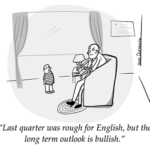For years, critics of test-based school accountability have pointed out that when schools face pressure to raise students’ scores in math and reading, they tend to respond by doubling down on those two subject areas and cutting back on the teaching of history, art, music, civics, and more. In short, when the spotlight focuses on a small part of the curriculum, other subjects get left in the shadows.
Less often recognized, but equally troublesome, is that recent school reforms haven’t just limited our view of what matters in education (what subject areas, what student outcomes, and what indicators of success) but also our view of who matters.
The major federal policy initiatives of the last decade and a half, No Child Left Behind and Race to the Top, were designed mainly to change the attitudes and behaviors of teachers and principals — the members of the school community known to have the greatest and most direct influence on students’ academic achievement. When schools have failed to make Adequate Yearly Progress, it has mostly been teachers and principals who’ve been slapped on the wrist or let go from their jobs. They’re the ones whose performance has been scrutinized in the media and evaluated in the workplace. And they, especially teachers, are the ones whose value-added scores have been calculated, who’ve been hired under alternative certifications, whose seniority rights have come under fire, and who’ve been singled out for merit pay.
Of course, the greater the attention to teachers and principals, the less notice has been taken of the many other adults who work in schools and districts: nurses, librarians, instructional coaches, principal supervisors, social workers, guidance counselors, human resource directors, bus drivers, and the list goes on. For better or worse, those people have mostly been left out of the headlines, the reform initiatives, the policy debates, and the performance indicators.
For this issue of Kappan, we’ve chosen to put many of these school and district staff members front and center. In part, we’ve done so for sentimental reasons — it just doesn’t seem fair to give so little attention to the many people, holding all sorts of job titles, who serve every day as students’ mentors, advisers, clinicians, protectors, tutors, confidants, early morning greeters, and on and on. More than that, though, we’ve chosen to feature them because they play critical roles in K-12 education. School systems can and should do much more to draw upon the knowledge and expertise of these staff members, and now that the national conversation about school improvement has begun to expand beyond its narrow fixation on test-score gains in reading and math, policy makers may be ready to take a fresh look at their work.
As a vast body of research now makes clear, young people’s success in school, college, the workplace, and the rest of life depends not just on their mastery of core academic content and skills but also — and often to a greater degree — on their beliefs and attitudes, personal dispositions, relationships, emotional intelligence, creativity, nutrition, mental health, knowledge about college and work opportunities, financial resources, willingness to engage with new people and cultures, openness to new experiences, and more. In that case, how can school reformers continue to operate on the assumption that everybody other than principals and classroom teachers plays a lesser role in students’ long-term success?
If our school staffing patterns provide a window into what we truly value, then data from the U.S. Department of Education (see pp. 40-41) suggest that we’re much more invested in our non-instructional staff today than we were a half-century ago, though the recent record is mixed. For example, librarians saw dramatic increases in their numbers from the 1950s through the dawn of the internet age in the 1990s, but they’ve experienced steep declines ever since. Counselors have done better, continuing to see their numbers grow a bit in recent years, even through the Great Recession. Then again, in spite of long-term growth in the ranks of these and other support staff, their numbers are still quite low. Only 40% of the country’s schools employ full-time nurses, for example, and a quarter of schools have no nurse at all. Nationally, we now have one guidance counselor for every 465 students, which represents a great improvement over the 1:2,400 ratio in 1960, but we’re nowhere close to the 1:250 ratio recommended by the American School Counselor Association.
In fact, though, staffing patterns give us only a partial indication of what we truly value. Just because one has been trained and hired as a school social worker or instructional coach, that doesn’t mean one will actually spend the bulk of one’s time doing that job. As described in the articles in this issue, school staff routinely find themselves pressed into service as testing coordinators, substitute teachers, chaperones, data analysts, and so on, diverting them from the important roles that they are ready, willing, and prepared to play in students’ lives. The challenge for all of us in public education is not just to bring these people back into the policy spotlight but also to protect their time, honor their professional identities, and allow them to play their proper roles.
Citation: Heller, R. (2018). Who matters? Phi Delta Kappan 99 (7), 4.
ABOUT THE AUTHOR

Rafael Heller
Rafael Heller is the former editor-in-chief of Kappan magazine.










